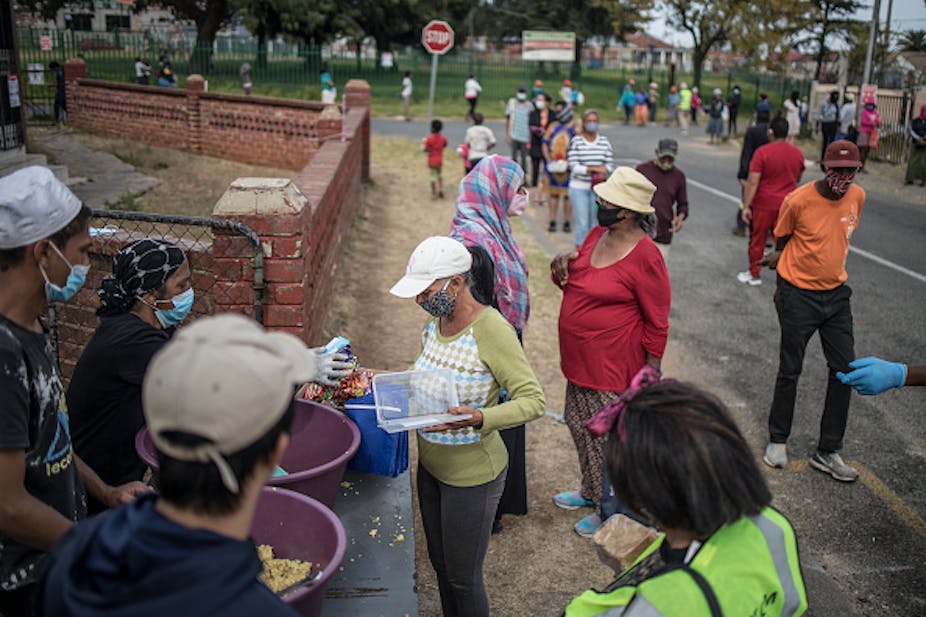Everyone is vulnerable in some way, whether it’s to natural disasters, chronic diseases or hunger. But some are more at risk than others because of what they are exposed to socially, economically and environmentally. This phenomenon is known as social vulnerability. It refers to the attributes of society that make people and places susceptible to natural disasters, adverse health outcomes and social inequalities.
In terms of income distribution, South Africa is one of the most unequal countries in the world. The impact of COVID-19 on the economy has worsened this inequality and increased social vulnerability among poor people. Poverty is inherently associated with food insecurity – a state in which socially vulnerable people can’t get enough nutritious and safe food.
Although these social inequalities are well documented in South Africa, not enough is known about the link between social vulnerability and food insecurity for the country as a whole.
Previous studies that investigated the relationship between social vulnerability and food insecurity have been limited to certain places, such as the poor and rural Eastern Cape province or the crowded urban area of Soweto. A better understanding of social inequalities at a national level might help the government provide social relief where it’s needed most.
With this in mind, we conducted a nationally representative survey of the prevalence of social vulnerability in the country. We looked at a range of socio-economic, demographic and geographical variables to see who is socially vulnerable. We also investigated the associations between social vulnerability and household food insecurity.
Questions about food
We conducted our study in October 2021 with 3,402 individuals we recruited across the nine provinces of the country. We used a statistical technique to transform the sample of 3,402 into a nationally representative sample of 39.6 million people, aged 18 years and older.
We measured social vulnerability using a social vulnerability index tool developed by the United States Centers for Disease Control and Prevention, which we adapted for South Africa.
We also used a modified version of the Community Childhood Hunger Identification Project questionnaire to quantify food insecurity.
Read more: South Africa's hunger problem is turning into a major health crisis
All the respondents were asked:
Does your household ever run out of money to buy food?
Do you ever cut the size of meals or skip meals because there is not enough money for food?
Do you or any of your children ever go to bed hungry because there is not enough money to buy food?
Vulnerable and food insecure
The study showed high levels of social vulnerability in the country linked to food insecurity. Over 20.6% of the South Africans in our sample were socially vulnerable, and 20.4% food insecure. This amounts to about 7.8 million people out of our sample of 39.6 million people.
We also found that the most vulnerable groups in the country were Africans – as opposed to white people or people of Asian or mixed descent.
Also most vulnerable were
females
people living in rural areas
those with low socio-economic status
people without high school certificates
adults older than 45.
Read more: Pandemic underscores gross inequalities in South Africa, and the need to fix them
These findings are not surprising, given that these groups are known to have higher levels of poverty. But the findings are still important because they paint a troubling picture in which social inequality remains a major and persisting national challenge. It needs urgent and efficient solutions.
Addressing social inequalities
The government uses various initiatives to address social inequalities in the country to good effect. These include public education and health services, school feeding schemes and the tax exemption of staple foods such as brown bread and rice.
Social grants are the largest source of support for many vulnerable groups. They are the government’s primary response to poverty, food insecurity and inequality.
The well-established grants system reaches 18.4 million beneficiaries (about 31% of the population).
Despite such efforts, social inequalities have consistently remained high. They are also unlikely to be eradicated with the current social initiatives because of several complex factors. These include the fact that social grants are unable to keep up with inflation in food prices.
Another problem is that recipients use the funds for many non-food necessities – such as clothing and transport costs. Other contributing factors are the gaps in the formulation and implementation of policies to address food insecurity.
Read more: South Africa has taken steps to help young jobless people. Here's what's working
There’s also a lack of collaboration from different stakeholders in the food system. For example, policymakers often view food insecurity as a rural issue. So, a majority of initiatives to address the problem focus on solutions related to food production. Yet, urban areas are also vulnerable to food insecurity as they depend more on the cash economy than rural areas.
In view of our findings, government and other stakeholders need to implement creative and targeted social strategies to reduce and eliminate food insecurity in highly vulnerable groups. Improving the economy and education system should be the main areas of focus in addressing social inequalities in the country.

